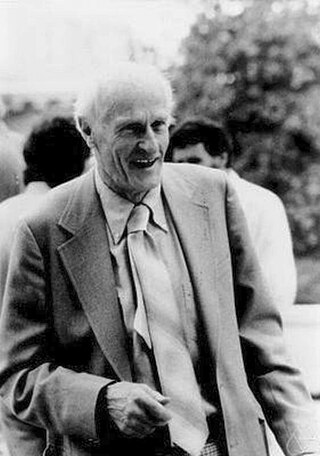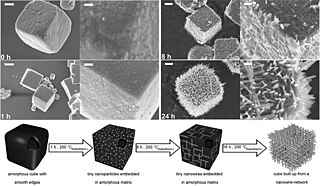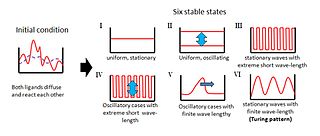Morphogenesis is the biological process that causes a cell, tissue or organism to develop its shape. It is one of three fundamental aspects of developmental biology along with the control of tissue growth and patterning of cellular differentiation.
The noosphere is a philosophical concept developed and popularized by the biogeochemist Vladimir Vernadsky, and philosopher and Jesuit priest Pierre Teilhard de Chardin. Vernadsky defined the noosphere as the new state of the biosphere and described as the planetary "sphere of reason". The noosphere represents the highest stage of biospheric development, that of humankind's rational activities.

Stephen Cole Kleene was an American mathematician. One of the students of Alonzo Church, Kleene, along with Rózsa Péter, Alan Turing, Emil Post, and others, is best known as a founder of the branch of mathematical logic known as recursion theory, which subsequently helped to provide the foundations of theoretical computer science. Kleene's work grounds the study of computable functions. A number of mathematical concepts are named after him: Kleene hierarchy, Kleene algebra, the Kleene star, Kleene's recursion theorem and the Kleene fixed-point theorem. He also invented regular expressions in 1951 to describe McCulloch-Pitts neural networks, and made significant contributions to the foundations of mathematical intuitionism.
An autocatalytic set is a collection of entities, each of which can be created catalytically by other entities within the set, such that as a whole, the set is able to catalyze its own production. In this way the set as a whole is said to be autocatalytic. Autocatalytic sets were originally and most concretely defined in terms of molecular entities, but have more recently been metaphorically extended to the study of systems in sociology, ecology, and economics.

The Radiolaria, also called Radiozoa, are protozoa of diameter 0.1–0.2 mm that produce intricate mineral skeletons, typically with a central capsule dividing the cell into the inner and outer portions of endoplasm and ectoplasm. The elaborate mineral skeleton is usually made of silica. They are found as zooplankton throughout the global ocean. As zooplankton, radiolarians are primarily heterotrophic, but many have photosynthetic endosymbionts and are, therefore, considered mixotrophs. The skeletal remains of some types of radiolarians make up a large part of the cover of the ocean floor as siliceous ooze. Due to their rapid change as species and intricate skeletons, radiolarians represent an important diagnostic fossil found from the Cambrian onwards.

The term autopoiesis refers to a system capable of producing and maintaining itself by creating its own parts. The term was introduced in the 1972 publication Autopoiesis and Cognition: The Realization of the Living by Chilean biologists Humberto Maturana and Francisco Varela to define the self-maintaining chemistry of living cells.
Robert Rosen was an American theoretical biologist and Professor of Biophysics at Dalhousie University.

Self-organization, also called spontaneous order in the social sciences, is a process where some form of overall order arises from local interactions between parts of an initially disordered system. The process can be spontaneous when sufficient energy is available, not needing control by any external agent. It is often triggered by seemingly random fluctuations, amplified by positive feedback. The resulting organization is wholly decentralized, distributed over all the components of the system. As such, the organization is typically robust and able to survive or self-repair substantial perturbation. Chaos theory discusses self-organization in terms of islands of predictability in a sea of chaotic unpredictability.

Manfred Eigen was a German biophysical chemist who won the 1967 Nobel Prize in Chemistry for work on measuring fast chemical reactions.

Sir D'Arcy Wentworth Thompson CB FRS FRSE was a Scottish biologist, mathematician and classics scholar. He was a pioneer of mathematical and theoretical biology, travelled on expeditions to the Bering Strait and held the position of Professor of Natural History at University College, Dundee for 32 years, then at St Andrews for 31 years. He was elected a Fellow of the Royal Society, was knighted, and received the Darwin Medal and the Daniel Giraud Elliot Medal.
Theoretical neuromorphology is the science of using morphology to mathematically describe the shape and the connectivity in the nervous system.
Complexity economics is the application of complexity science to the problems of economics. It relaxes several common assumptions in economics, including general equilibrium theory. While it does not reject the existence of an equilibrium, it sees such equilibria as "a special case of nonequilibrium", and as an emergent property resulting from complex interactions between economic agents. The complexity science approach has also been applied to computational economics.
A nonlinear dynamical system exhibits chaotic hysteresis if it simultaneously exhibits chaotic dynamics and hysteresis. As the latter involves the persistence of a state, such as magnetization, after the causal or exogenous force or factor is removed, it involves multiple equilibria for given sets of control conditions. Such systems generally exhibit sudden jumps from one equilibrium state to another. If chaotic dynamics appear either prior to or just after such jumps, or are persistent throughout each of the various equilibrium states, then the system is said to exhibit chaotic hysteresis. Chaotic dynamics are irregular and bounded and subject to sensitive dependence on initial conditions.
John Barkley Rosser Jr. was a mathematical economist and Professor of Economics at James Madison University in Harrisonburg, Virginia since 1988. He was known for work in nonlinear economic dynamics, including applications in economics of catastrophe theory, chaos theory, and complexity theory. With Marina V. Rosser he invented the concept of the "new traditional economy". He introduced into economic discourse the concepts of chaotic bubbles, chaotic hysteresis, and econochemistry. He also invented the concepts of the megacorpstate and hypercyclic morphogenesis. He was the first to provide a mathematical model of the period of financial distress in a speculative bubble. With Marina V. Rosser and Ehsan Ahmed, he was the first to argue for a two-way positive link between income inequality and the size of an underground economy in a nation. Rosser's equation has been used to forecast ratios of future Social Security benefits to current ones in real terms.

The term chemoton refers to an abstract model for the fundamental unit of life introduced by Hungarian theoretical biologist Tibor Gánti. Gánti conceived the basic idea in 1952 and formulated the concept in 1971 in his book The Principles of Life. He suggested that the chemoton was the original ancestor of all organisms.
Social corporatism, also called social democratic corporatism, is a form of economic tripartite corporatism based upon a social partnership between the interests of capital and labour, involving collective bargaining between representatives of employers and of labour mediated by the government at the national level. Social corporatism is present to a lesser degree in the Western European social market economies. It is considered a compromise to regulate the conflict between capital and labour by mandating them to engage in mutual consultations that are mediated by the government.

In chemistry, a hypercycle is an abstract model of organization of self-replicating molecules connected in a cyclic, autocatalytic manner. It was introduced in an ordinary differential equation (ODE) form by the Nobel Prize in Chemistry winner Manfred Eigen in 1971 and subsequently further extended in collaboration with Peter Schuster. It was proposed as a solution to the error threshold problem encountered during modelling of replicative molecules that hypothetically existed on the primordial Earth. As such, it explained how life on Earth could have begun using only relatively short genetic sequences, which in theory were too short to store all essential information. The hypercycle is a special case of the replicator equation. The most important properties of hypercycles are autocatalytic growth competition between cycles, once-for-ever selective behaviour, utilization of small selective advantage, rapid evolvability, increased information capacity, and selection against parasitic branches.
A social-ecological system consists of 'a bio-geo-physical' unit and its associated social actors and institutions. Social-ecological systems are complex and adaptive and delimited by spatial or functional boundaries surrounding particular ecosystems and their context problems.

The Turing pattern is a concept introduced by English mathematician Alan Turing in a 1952 paper titled "The Chemical Basis of Morphogenesis" which describes how patterns in nature, such as stripes and spots, can arise naturally and autonomously from a homogeneous, uniform state. The pattern arises due to Turing instability which in turn arises due to the interplay between differential diffusion of chemical species and chemical reaction. The instability mechanism is unforeseen because a pure diffusion process would be anticipated to have a stabilizing influence on the system.
Thomas Lecuit, born 4 October 1971 in Saumur, is a French biologist specializing in the emergence of forms or morphogenesis. He is a professor at the Collège de France, holding the Dynamics of Life Chair. He leads a research team at the Institut de Biologie du Développement de Marseille (IBDM), and the Turing Centre for Living Systems, an interdisciplinary centre dedicated to the study of living organisms.








